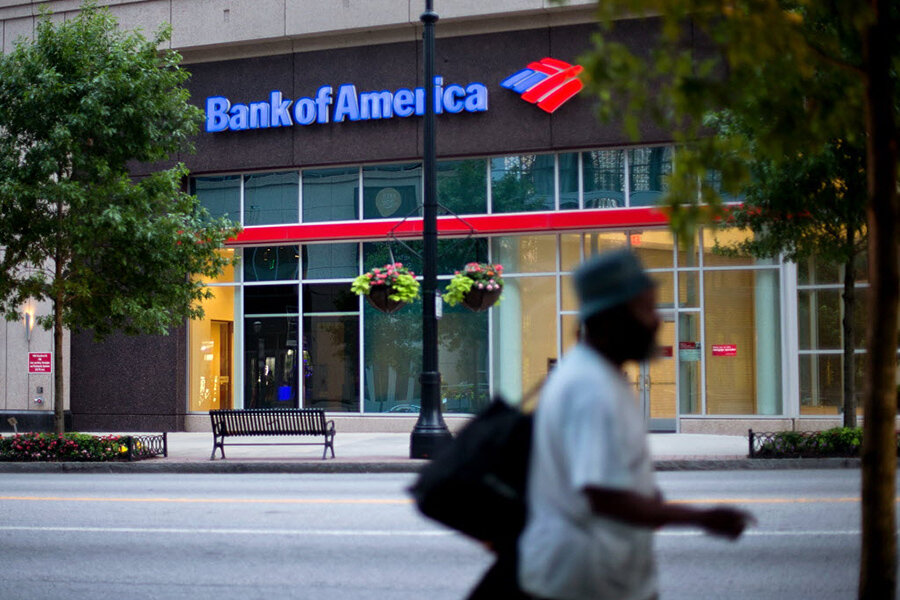Mobile payments too slow? Big banks introduce speedy new plan.
Loading...
Beginning this week, customers at several of the country’s largest banks will be able use their mobile phones to send money, split a rent check, or share a restaurant bill.
On Wednesday, the service went live for Bank of America customers, while US Bank said it had plugged into the system, known as clearXchange, last week. It’s jointly owned by the banks.
JP Morgan Chase, Wells Fargo, and Capital One are set to enable the mobile payments system later this year, Reuters reports, while PNC Bank may also join in.
With clearXchange, the banks are betting that the system’s promise of making payment transfers nearly instantaneous will spur more people to use it for a range of tasks.
“We’re focused on creating a simple, straightforward person-to-person payments experience that lets our customers pay anyone with a couple of easy, intuitive steps,” says Thong Nguyen, president of retail banking at Bank of America, in a statement.
But the marketplace for mobile payments has grown increasingly crowded. Distinguishing between the array of rival payment systems can sometimes be difficult.
Services such as Square, PayPal’s Venmo, Google’s Wallet, and Facebook — where users can send money using the Messenger app — offer options that particularly appeal to younger consumers.
Apple, Google, and Samsung also offer mobile payment systems that let customers pay for goods using their phones, though they can’t send money directly, a feature that is widely used elsewhere in the world.
Last fall, Apple applied for a patent for person-to-person payments and has been discussing introducing a system with several large banks, but it hasn’t yet launched.
For the banks, the speed of the clearXchange system may offer a way to distinguish it from competitors such as Venmo, where transferring cash to someone with a bank account from another institution can take one to three days. Using the new system, that transfer happens almost instantly.
The sheer amount of cash that banks handle could also be an advantage, though the use of services such as Venmo is growing. Customers sent $7.5 billion in person-to-person payments using PayPal’s Venmo last year, while $22 billion was exchanged digitally by customers at Bank of America.
But despite their size, banks have been slow to adapt to changing digital technology.
By 2014, 73 percent of banks of various sizes offered mobile banking features, a survey released last year by Boston’s Federal Reserve found. A second survey by the national Federal Reserve found that 35 percent of users said they used them.
While the number of people using mobile banking systems is increasing, with black and Latino consumers particularly likely to make mobile payments, many users still appeared to prefer other options, including online banking and visiting a traditional branch, the survey found.
Last year, the Consumer Financial Protection Bureau, the nation’s consumer watchdog also weighed in.
Surveying a range of banks, technology providers and social justice groups, the bureau found that mobile banking systems could particularly help low-income consumers gain access to financial services when a traditional bank branch is out of reach.
For banks, reaching “unbanked” or “underbanked” consumers can be a Catch-22. Consumers who face language barriers are more likely to need assistance provided by employees at a branch, noted Risa Freedman, a director at Deloitte Services LP, the auditing firm, in a response to the bureau’s inquiry into mobile banking.
“Mobile can help solve this problem. Customers that cannot be served economically using traditional channels can be efficiently reached using the lower cost mobile channel, thereby increasing financial access,” she wrote.
But some tech companies expressed skepticism. “The banks have a hard time working with one another," Bill Ready, PayPal’s global head of product and engineering, told Reuters.
One of Venmo’s key advantages, he says, is its “viral nature” that allows the product’s features to spread by word of mouth rather than traditional marketing, he says.
The network used by PayPal and other tech companies to make the transfers work is also planning to begin introducing daily transfers of cash in September, possibly blunting the advantage of the banks’ clearXchange system.
Other collaborations, such as a plan by a group of retailers known as the Merchant Customer Exchange – which includes 7-Eleven, Best Buy, CVS, Lowe’s and, Target – to introduce their own mobile payment system, have long been stalled, analysts say.
The banks point to clearXchange’s advantages, such as the benefit of additional fraud protection features at a time when many consumers say security concerns are the reason they don’t use mobile payment. But they also acknowledge that the service could struggle to compete with the tech companies’ offerings.
They’re hoping to launch a marketing campaign later in the year and have considered changing the service’s name to catch more users’ interest, Mary Harman, managing director of payments at Bank of America, told Reuters.
“The important thing is that we are acting now,” she says.





